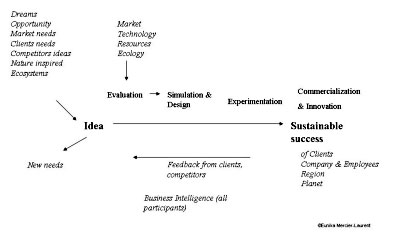By: Eunika Mercier-Laurent
Do we have too static and rigid a view of innovation? It should be all about dynamic connections, imagination, experience and the interconnection of people and machines. In short it should be about identifying, understanding and exploiting innovation ecosystems, says Eunika Mercier-Laurent, author of The Innovation Ecosystem.
More than ever, the capacity to innovate is a fundamental resource of organizations as well as the true wealth of a society. To contribute fully to the prosperity of an organization, region or country, the innovation process requires the implementation of knowledge dynamics between domains that are often treated in isolation.
This dynamic is based on a synergy between humans and intelligent machines. More broadly, ‘knowledge innovation’ is a combination of knowledge, imagination and experience, the ability to transcend the boundaries between domains, to make linkages and operate as interdependent parts.
Ecosystems of innovation include diverse facets. They bring out the concept of “e-co-innovation”, which – far from being a fad – brings a better understanding of the successful transition from idea to reality and ultimate value. Among some aspects of e-co-innovation: e- as economic, educative, environmental, electronic and ethics; co- as collaborative, co-design, common values, collective intelligence, knowledge and experience, convergence of intelligences – human and artificial; eco- as ecosystems – those of enterprise, regions and countries.
The economic effects of the innovation can not be fully achieved without deep understanding of all system components (global view) and their mutual influence (system view). A holistic view helps in situating innovation in the various contexts such as companies, society and environment.
Current management methods should be better adapted to the conditions generated by global change. While many people still act in “faster cheaper better” mode, some experiment with Corporate Social Responsibility (CSR). The CSR and classic “eco-innovation” as well, focus mainly on the optimization of energy in data centers, the reduction of CO2 emission, clean transportation and renewable energy and other topics aiming in the reduction of the impact on the ecosystems. The CSR is also considered as a source of new businesses, it is the basis of the IBM offer “Smart Planet”.
Another trend – the functionality economy – aims at offering not the product, but the functionality of the product; for example, Michelin now sells the use of their tires, including control and maintenance services, not just the tire.
The Knowledge Economy goes therefore further than the old product economy by offering, and building in, more intangibles such as expertise, feedback from experience, advice or relevant training and different thinking.
The transition from Industrial to Knowledge Economy is not trivial; it involves essential changes in the way of thinking, doing things and measuring the benefits. While the majority of people now expect to acquire knowledge for free from the Internet and social networks, they are not sure to find the associated “know-how” to explore and use this knowledge.
In fact we are dependent still on the old view of technology and education as drivers of innovation whereas we need to deal much more with this loose ecosystem and its infrastructure of constant knowledge.
The economic situation of the developed countries convinces many experts that technological innovation is the only possibility to survive and regain a leadership position. So, many actors limit their inquiry to technological innovation and consider that to innovate well we need to improve, for example, higher education.
However, the economic effects of innovation do not depend on the absorbed knowledge of an education system but on the capacity to transform knowledge into the expected products and services, to create new needs and to get values via new (non polluting) business models.
The sine qua non condition for surviving of the developed countries is to switch to a continuous e-co-innovation and sustainable success management.
This innovation process involves the art of managing tangible and to a large extent, the intangibles. The new management skills includes: imagination, mental flexibility, feeling, communication capacity (dynamics of a continuous innovation process), knowledge and relevant use of ICT , link making, opportunity hunting, risk taking, the art of Intellectual Capital management including collective intelligence and motivation, achieving and maintaining a leader position, intelligent work with selected competitors and some others. The role of education/training is to introduce this innovation culture through various actions.
It includes, among others, the capacity to innovate with clients and partners, to collaborate instead of competing, to share the feedback from experience and learn continuously from exchanges and observations. Instead of losing time to fight with competitors, sometimes working with them can bring a better solution for client. The nature-inspired innovation respecting the ecosystems is a part of this new culture.
The sustainable success in Knowledge Economy depends on the capacity to manage the intangible and the e-co-innovation process, shown on the Figure 1.

The e-co-innovation process is composed of two parts: creativity and transformation of ideas. An idea can address the detected needs or invent new needs.
Many companies still practice first generation innovation where only R&D drives innovation. They try many creativity methods, but while there are a lot of ideas ‘outside’ the company, they are not managed effectively necessarily when they are brought in.
Many companies on the other hand are involved in ecosystems of social networks but only a few know how to generate business from these interactions.
We need a strategic ‘Knowledge Innovation’ approach that will help to collect, share, make know and explore interesting ideas inside a company (participative innovation), outside (open innovation) and between organizations (global innovation). It provides a framework for managing the knowledge activities of ecosystems, including the measures on regular basis of the capacity to innovate and the resulting benefits. It will need to manage the interaction between people in different domains that appear unconnected – those connection points however are where true innovations lie.
By Eunika Mercier-Laurent
About the author:
 Prof. Eunika Mercier-Laurent is a Global Innovation Strategist and Founder of SMLE – for Knowledge & Innovation Management since 1994, President of Innovation3D, and E100 expert of ENTOVATION International since 1996.
Prof. Eunika Mercier-Laurent is a Global Innovation Strategist and Founder of SMLE – for Knowledge & Innovation Management since 1994, President of Innovation3D, and E100 expert of ENTOVATION International since 1996.
Her own specialties include: sustainable innovation management, architecture of knowledge flow, complex industrial problem solving using knowledge engineering methods and tools, collective experience for technical diagnostic and risk management, collective intelligence, knowledge discovery, decision support systems, e-learning and knowledge transfer methods.
She is associate Researcher at IAE Lyon University, where she got her HDR in 2007. She is teacher and e-teacher of Knowledge Innovation and knowledge thinking approach in engineering schools and universities. Main topic of her research work is about transforming all forms of computers into intelligent assistants of humans. She is member of Institut F.R. Bull, multidisciplinary group working on influence of new technologies on different areas like decision in complex environment, complex systems security, medicine; influence of natural on artificial brains and machines. Other honors and activities: AFIA, CAAI; EC, OSEO, ANR expert, cofounder of the Mediterranean University of Innovation, organizer and co-organizer of several scientific conferences, member of IFIP TC12 and chair of TC 12.6 on Knowledge Management. She is frequently invited talk at the international conferences, author of tutorials and over 50 international publications and books.
